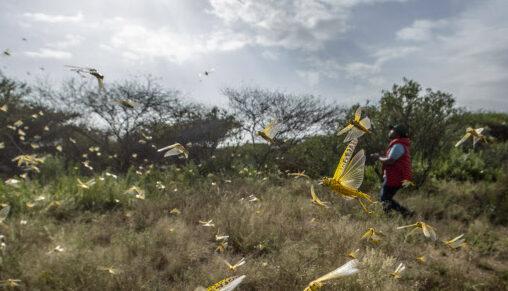Africa-Press – Mauritius. These clouds—swarms of millions of voracious desert locusts—began raising concerns in East Africa in June 2019 after traveling hundreds of miles from the Arabian Peninsula.
By February 2020, the crisis forced the United Nations’ Food and Agriculture Organization (FAO) to sound the alarm, making an appeal of $76m to its international partners to control the locusts’ spread not only in Ethiopia, but Kenya, Somalia, South Sudan, Uganda, and Tanzania as well.
The FAO has cause to be alarmed: an average swarm of 40 million locusts can travel up to 90 miles and eat enough food to feed 35,000 people in a single day.
Unfortunately, East Africa’s long rains and planting season is coinciding with the spread of the locust swarms. Due to the rains, the region is producing an abundance of vegetation, which allows these locust populations to mature and explode into the billions.
On top of that, the arrival of the COVID-19 pandemic on the continent only serves to complicate the response of vulnerable East African communities. Considering these threats, the path to acute food insecurity and economic backsliding is ominously clear.
To successfully respond to this crisis that could become 400 times worse by this June, the FAO and its partners must increase emergency funding to this cause, increase focus on country-led efforts to strengthen short and long-term pest surveillance, and strengthen smallholder farmers’ long-term resilience beyond the use of chemical pesticides.
Increasing Emergency Funding The FAO, private donors, and wealthy donor countries must increase emergency funding to respond to this crisis. The Global Locust Initiative at Arizona State University highlights that $450 m was needed to stop the 2003-2005 desert locust plague, which caused $2.5bn in crop damage.
In the face of a plague whose severity has not been experienced by the region for decades, the FAO has since increased the amount of money it has asked of partners from $76m to $153m. While a mere fraction of the amount was spent nearly two decades ago, today the FAO is short $42 million.
The money will not solve everything, but it is a necessary first step to helping countries like Uganda—where the government is struggling to budget for both locust control and coronavirus mitigation—provide emergency food assistance to affected populations, and pay for the pesticides, equipment, and training necessary to control swarms.
Strengthening Pest Surveillance The FAO and its partners must continue increasing country-led efforts to strengthen short and long-term pest surveillance.
One of the main issues in detecting locust swarms in their earlier generations is that they often begin in remote, desert areas. This issue of detection is then exacerbated by government systems that are underfunded, undertrained, or understaffed.
As a result, a lack of routine pest surveillance by governments is common. By engaging with East African governments, investing in pest-tracking technology, and sharing expertise (e. g.
, from US government bodies like the US Department of Agriculture and US Agency for International Development), the international community would better equip these countries to monitor and combat swarms within their borders for the rest of this year and for years to come.
Moreover, as experts from wealthy donor countries are currently facing coronavirus-related travel restrictions, having local staff and farmers adequately trained in reporting real-time surveillance data, using satellite-enabled handheld devices, to national locust centers and the FAO will prove critical.
Investing in Farmers’ Resilience With much of the response dedicated to spraying chemical pesticides across the region, the FAO and its partners must consider the long-term investments needed to strengthen smallholder farmers’ resilience beyond the use of chemical pesticides.
Indeed, one concern with chemical pesticides is their diminishing return over time: insects like locusts may become resistant. In the longer term, the FAO and its partners should continue developing and testing tools like biopesticides (e.
g. , natural predators, plants, and bacteria) and diversifying the crops farmers are growing (e. g. , low-carbohydrate millet disliked by locusts). Not only could these alternatives strengthen farmers’ first line of defense from future swarms, but they can also be less harmful than chemical pesticides in terms of their effect on human and livestock health.
This is not to say that chemical pesticides should not be used. Indeed, as the crisis continues to unfold, aerial spraying is still the most effective way to address these swarms.
However, investing in smallholder farmers’ resilience as this plague reaches its end will save time, money, and other resources when the next plague begins. Overshadowed by COVID-19
Faced with wall-to-wall coverage of the COVID-19 pandemic, it is possible that private donors and wealthy governments will be too distracted or simply less inclined to donate to locust control efforts.
International partners may assume that, because of government-mandated movement restrictions, investing in pest surveillance training of local staff is futile.
And, in dealing with two escalating crises, the international community may also lose sight of the long-term benefits of investing in farmers’ resilience.
While theoretically understandable, any such hesitancy or lack of prioritization of this problem by private donors and wealthy countries will lead to disaster.
All major international actors dedicated to East Africa’s developmental success must act now or an already-fragile region could see 19 million people at risk of severe food insecurity.
It is not difficult to imagine how these swarms could erase significant development gains made by the region’s agriculture-based economies and hamper their ability to bounce back from future shocks.
Bottom line: East Africa needs funding, country-led pest surveillance, and an eye toward strengthening the resilience of smallholder farmers beyond chemical pesticides. Without fully funded solutions, the FAO and its partners would, in many ways, be leaving the region’s future to its gods, infuriated or not.
For More News And Analysis About Mauritius Follow Africa-Press







